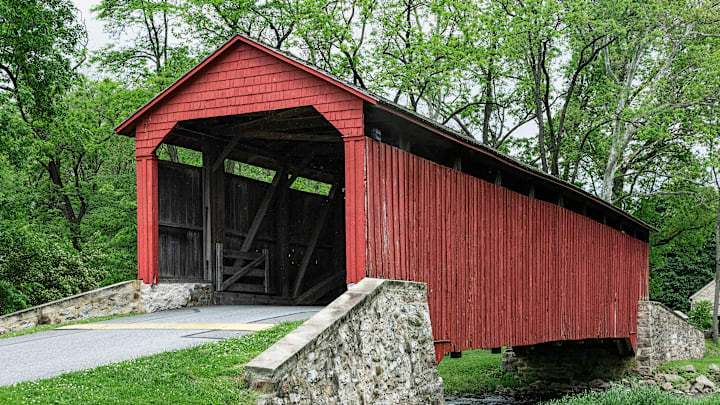Covered bridges. What is the fascination with them? They can be quite picturesque and have become the subjects of artists of paint and photography.
A typical covered bridge is a timber truss bridge with a roof, decking, and siding which creates an almost total enclosure for the length of the span. As the bridges were constructed from timber, they were covered to lengthen the life span of the structures.
Many of the bridges were built in the late 18th Century and into the early 19th Century. The ones that have survived are old. In fact, the ones that have survived have become the focus of tourists, many of them now certified as historical landmarks.
There are reported to be about 750 covered bridges throughout the Continental United States with the majority found in states east of the Mississippi River. Pennsylvania has the most covered bridges with a last count of 210. Ohio has 125 and Vermont has 100.
Pennsylvania’s Lancaster County, famous for its large Amish population, is the county with the most operating covered bridges in the State of Pennsylvania with 29, second most in the country.
Lancaster County’s covered bridges are so popular that it plays host to the Covered Bridge Classic, a bicycle riding event that takes riders on a tour of, and through, many of the County’s covered bridges. There are four routes – 100 miles through 14 bridges; 66 miles and 8 bridges; 50 miles and 7 bridges; and 34 miles with 5 bridges.
The most popular covered bridge in the County seems to be Hunsecker’s Mill Covered Bridge, built in 1848, over Conestoga Creek, on Hunsicker Road. Ironically, it’s the only one of the County’s covered bridges not listed on the National Register of Historic Places.
If you are simply driving around Lancaster County’s backroads and through its vast farmlands, you would be hard-pressed not to happen upon a covered bridge. And if you are patient, you can definitely see a horse-drawn buggy passing through.
Ohio, like its neighboring Pennsylvania, also has a large Amish population and farming community. Similarly, it has quite a number of still operational covered bridges.
Ashtabula County leads the way with 19 covered bridges and Fairfeld County is just one behind with 18.
The Smolen-Gulf Bridge is reportedly the longest multi-span covered bridge in the country at 613 feet, while the West Liberty Covered Bridge is the shortest at a mere 18 feet.
Some of the more popular bridges are Hanaway Covered Bridge in Two Glaciers Park in Fairfield County; George Hutchins Covered Bridge in Alley Park in Hocking Hills; and Bethel-New Hope Bridge in Brown County.
There are many picture spots, most notably those in the area of Hocking Hills.
Vermont has the reputation for being home to the Cornish-Windsor Covered Bridge, the longest wooden bridge in the United States, and the longest two-span covered bridge in the world, connecting the state to neighboring New Hampshire.
Montgomery, Vermont has the most covered bridges with a total of six within its town limits and another right on its border, all with a similar town lattice style construction.
In addition to the Cornish-Windsor Bridge, Emily’s Bridge in Stowe, Vermont and Great Eddy Covered Bridge in Waitsfield, Vermont are two of the more popular spans.
Vermont’s relatively small size makes it quite easy to see many of these beautiful structures in a short period of time.
So when thinking about a road trip this fall to see the foliage, you might want to take a drive and take a drive through history…you can always use the falls colors as beautiful backdrop for the photo op.
